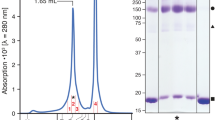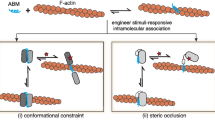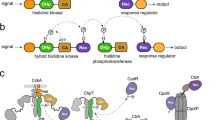Abstract
Huntingtin-interacting protein-1 related (HIP1R) has a crucial protein-trafficking role, mediating associations between actin and clathrin-coated structures at the plasma membrane and trans-Golgi network. Here, we characterize the F-actin–binding region of HIP1R, termed the talin-HIP1/R/Sla2p actin-tethering C-terminal homology (THATCH) domain. The 1.9-Å crystal structure of the human HIP1R THATCH core reveals a large sequence-conserved surface patch created primarily by residues from the third and fourth helices of a unique five-helix bundle. Point mutations of seven contiguous patch residues produced significant decreases in F-actin binding. We also show that THATCH domains have a conserved C-terminal latch capable of oligomerizing the core, thereby modulating F-actin engagement. Collectively, these results establish a framework for investigating the links between endocytosis and actin dynamics mediated by THATCH domain–containing proteins.
This is a preview of subscription content, access via your institution
Access options
Subscribe to this journal
Receive 12 print issues and online access
$259.00 per year
only $21.58 per issue
Buy this article
- Purchase on SpringerLink
- Instant access to full article PDF
Prices may be subject to local taxes which are calculated during checkout





Similar content being viewed by others
References
Cremona, O. & De Camilli, P. Phosphoinositides in membrane traffic at the synapse. J. Cell Sci. 114, 1041–1052 (2001).
Owen, D.J., Collins, B.M. & Evans, P.R. Adaptors for clathrin coats: structure and function. Annu. Rev. Cell Dev. Biol. 20, 153–191 (2004).
Ritter, B. & McPherson, P.S. Molecular mechanisms in clathrin-mediated membrane budding. in Regulatory Mechanisms of Intracellular Membrane Transport, Vol. 10 (eds. Keranen, S. & Jantti, J.) 9–38 (Springer-Verlag, Berlin, Heidelberg, 2004).
Engqvist-Goldstein, A.E. & Drubin, D.G. Actin assembly and endocytosis: from yeast to mammals. Annu. Rev. Cell Dev. Biol. 19, 287–332 (2003).
McPherson, P.S. The endocytic machinery at an interface with the actin cytoskeleton: a dynamic, hip intersection. Trends Cell Biol. 12, 312–315 (2002).
Merrifield, C.J. Seeing is believing: imaging actin dynamics at single sites of endocytosis. Trends Cell Biol. 14, 352–358 (2004).
Munn, A.L. Molecular requirements for the internalisation step of endocytosis: insights from yeast. Biochim. Biophys. Acta 1535, 236–257 (2001).
Kubler, E. & Riezman, H. Actin and fimbrin are required for the internalization step of endocytosis in yeast. EMBO J. 12, 2855–2862 (1993).
Ayscough, K.R. et al. High rates of actin filament turnover in budding yeast and roles for actin in establishment and maintenance of cell polarity revealed using the actin inhibitor latrunculin-A. J. Cell Biol. 137, 399–416 (1997).
Fujimoto, L.M., Roth, R., Heuser, J.E. & Schmid, S.L. Actin assembly plays a variable, but not obligatory role in receptor-mediated endocytosis in mammalian cells. Traffic 1, 161–171 (2000).
Yarar, D., Waterman-Storer, C.M. & Schmid, S.L. A dynamic actin cytoskeleton functions at multiple stages of clathrin-mediated endocytosis. Mol. Biol. Cell 16, 964–975 (2005).
Engqvist-Goldstein, A.E. et al. RNAi-mediated Hip1R silencing results in stable association between the endocytic machinery and the actin assembly machinery. Mol. Biol. Cell 15, 1666–1679 (2004).
Merrifield, C.J., Feldman, M.E., Wan, L. & Almers, W. Imaging actin and dynamin recruitment during invagination of single clathrin-coated pits. Nat. Cell Biol. 4, 691–698 (2002).
Carreno, S., Engqvist-Goldstein, A.E., Zhang, C.X., McDonald, K.L. & Drubin, D.G. Actin dynamics coupled to clathrin-coated vesicle formation at the trans-Golgi network. J. Cell Biol. 165, 781–788 (2004).
Kessels, M.M., Engqvist-Goldstein, A.E., Drubin, D.G. & Qualmann, B. Mammalian Abp1, a signal-responsive F-actin-binding protein, links the actin cytoskeleton to endocytosis via the GTPase dynamin. J. Cell Biol. 153, 351–366 (2001).
Cao, H. et al. Cortactin is a component of clathrin-coated pits and participates in receptor-mediated endocytosis. Mol. Cell. Biol. 23, 2162–2170 (2003).
Qualmann, B. & Kelly, R.B. Syndapin isoforms participate in receptor-mediated endocytosis and actin organization. J. Cell Biol. 148, 1047–1062 (2000).
Hussain, N.K. et al. Endocytic protein intersectin-l regulates actin assembly via Cdc42 and N-WASP. Nat. Cell Biol. 3, 927–932 (2001).
Buss, F., Arden, S.D., Lindsay, M., Luzio, J.P. & Kendrick-Jones, J. Myosin VI isoform localized to clathrin-coated vesicles with a role in clathrin-mediated endocytosis. EMBO J. 20, 3676–3684 (2001).
Merrifield, C.J., Qualmann, B., Kessels, M.M. & Almers, W. Neural Wiskott Aldrich Syndrome Protein (N-WASP) and the Arp2/3 complex are recruited to sites of clathrin-mediated endocytosis in cultured fibroblasts. Eur. J. Cell Biol. 83, 13–18 (2004).
Engqvist-Goldstein, A.E., Kessels, M.M., Chopra, V.S., Hayden, M.R. & Drubin, D.G. An actin-binding protein of the Sla2/Huntingtin interacting protein 1 family is a novel component of clathrin-coated pits and vesicles. J. Cell Biol. 147, 1503–1518 (1999).
Gervais, F.G. et al. Recruitment and activation of caspase-8 by the Huntingtin-interacting protein Hip-1 and a novel partner Hippi. Nat. Cell Biol. 4, 95–105 (2002).
Chopra, V.S. et al. HIP12 is a non-proapoptotic member of a gene family including HIP1, an interacting protein with huntingtin. Mamm. Genome 11, 1006–1015 (2000).
Metzler, M. et al. HIP1 functions in clathrin-mediated endocytosis through binding to clathrin and adaptor protein 2. J. Biol. Chem. 276, 39271–39276 (2001).
Mishra, S.K. et al. Clathrin- and AP-2-binding sites in HIP1 uncover a general assembly role for endocytic accessory proteins. J. Biol. Chem. 276, 46230–46236 (2001).
Legendre-Guillemin, V., Wasiak, S., Hussain, N.K., Angers, A. & McPherson, P.S. ENTH/ANTH proteins and clathrin-mediated membrane budding. J. Cell Sci. 117, 9–18 (2004).
Brett, T.J., Traub, L.M. & Fremont, D.H. Accessory protein recruitment motifs in clathrin-mediated endocytosis. Structure (Camb). 10, 797–809 (2002).
Legendre-Guillemin, V. et al. HIP1 and HIP12 display differential binding to F-actin, AP2, and clathrin. Identification of a novel interaction with clathrin light chain. J. Biol. Chem. 277, 19897–19904 (2002).
Chen, C.Y. & Brodsky, F.M. Huntingtin-interacting protein 1 (Hip1) and Hip1-related protein (Hip1R) bind the conserved sequence of clathrin light chains and thereby influence clathrin assembly in vitro and actin distribution in vivo. J. Biol. Chem. 280, 6109–6117 (2005).
Legendre-Guillemin, V. et al. Huntingtin interacting protein 1 (HIP1) regulates clathrin assembly through direct binding to the regulatory region of the clathrin light chain. J. Biol. Chem. 280, 6101–6108 (2005).
McCann, R.O. & Craig, S.W. The I/LWEQ module: a conserved sequence that signifies F-actin binding in functionally diverse proteins from yeast to mammals. Proc. Natl. Acad. Sci. USA 94, 5679–5684 (1997).
McCann, R.O. & Craig, S.W. Functional genomic analysis reveals the utility of the I/LWEQ module as a predictor of protein:actin interaction. Biochem. Biophys. Res. Commun. 266, 135–140 (1999).
Engqvist-Goldstein, A.E. et al. The actin-binding protein Hip1R associates with clathrin during early stages of endocytosis and promotes clathrin assembly in vitro. J. Cell Biol. 154, 1209–1223 (2001).
Kowanetz, K. et al. CIN85 associates with multiple effectors controlling intracellular trafficking of epidermal growth factor receptors. Mol. Biol. Cell 15, 3155–3166 (2004).
Kaksonen, M., Sun, Y. & Drubin, D.G. A pathway for association of receptors, adaptors, and actin during endocytic internalization. Cell 115, 475–487 (2003).
Baggett, J.J., D'Aquino, K.E. & Wendland, B. The Sla2p talin domain plays a role in endocytosis in Saccharomyces cerevisiae. Genetics 165, 1661–1674 (2003).
Holm, L. & Sander, C. Dali: a network tool for protein structure comparison. Trends Biochem. Sci. 20, 478–480 (1995).
Bakolitsa, C., de Pereda, J.M., Bagshaw, C.R., Critchley, D.R. & Liddington, R.C. Crystal structure of the vinculin tail suggests a pathway for activation. Cell 99, 603–613 (1999).
Breiter, D.R. et al. Molecular structure of an apolipoprotein determined at 2.5-Å resolution. Biochemistry 30, 603–608 (1991).
Senetar, M.A., Foster, S.J. & McCann, R.O. Intrasteric inhibition mediates the interaction of the I/LWEQ module proteins Talin1, Talin2, Hip1, and Hip12 with actin. Biochemistry 43, 15418–15428 (2004).
Dominguez, R. Actin-binding proteins–a unifying hypothesis. Trends Biochem. Sci. 29, 572–578 (2004).
Lijnzaad, P., Berendsen, H.J. & Argos, P. Hydrophobic patches on the surfaces of protein structures. Proteins 25, 389–397 (1996).
Mills, I.G. et al. Huntingtin interacting protein 1 modulates the transcriptional activity of nuclear hormone receptors. J. Cell Biol. 170, 191–200 (2005).
Gaidarov, I., Krupnick, J.G., Falck, J.R., Benovic, J.L. & Keen, J.H. Arrestin function in G protein-coupled receptor endocytosis requires phosphoinositide binding. EMBO J. 18, 871–881 (1999).
Ford, M.G. et al. Simultaneous binding of PtdIns(4,5)P2 and clathrin by AP180 in the nucleation of clathrin lattices on membranes. Science 291, 1051–1055 (2001).
Ford, M.G. et al. Curvature of clathrin-coated pits driven by epsin. Nature 419, 361–366 (2002).
Mishra, S.K. et al. Disabled-2 exhibits the properties of a cargo-selective endocytic clathrin adaptor. EMBO J. 21, 4915–4926 (2002).
Mishra, S.K., Watkins, S.C. & Traub, L.M. The autosomal recessive hypercholesterolemia (ARH) protein interfaces directly with the clathrin-coat machinery. Proc. Natl. Acad. Sci. USA 99, 16099–16104 (2002).
Metzler, M. et al. Disruption of the endocytic protein HIP1 results in neurological deficits and decreased AMPA receptor trafficking. EMBO J. 22, 3254–3266 (2003).
Otwinowski, Z. & Minor, W. Processing of X-ray diffraction data collected in oscillation mode. Methods Enzymol. 276, 307–326 (1997).
Schneider, T.R. & Sheldrick, G.M. Substructure solution with SHELXD. Acta Crystallogr. D Biol. Crystallogr. 58, 1772–1779 (2002).
de La Fortelle, E. & Bricogne, G. Maximum-likelihood heavy-atom parameter refinement for multiple isomorphous replacement and multiwavelength anomalous diffraction methods. Methods Enzymol. 276, 472–494 (1997).
Abrahams, J.P. & Leslie, A.G.W. Methods used in the structure determination of bovine mitochondrial F1 ATPase. Acta Crystallogr. D Biol. Crystallogr. 52, 30–42 (1996).
Perrakis, A., Morris, R. & Lamzin, V.S. Automated protein model building combined with iterative structure refinement. Nat. Struct. Biol. 6, 458–463 (1999).
Jones, T.A., Zou, J.Y., Cowan, S.W. & Kjeldgaard, M. Improved methods for binding protein models in electron density maps and the location of errors in these models. Acta Crystallogr. A 47 (Pt. 2), 110–119 (1991).
Brunger, A.T. et al. Crystallography & NMR system: A new software suite for macromolecular structure determination. Acta Crystallogr. D Biol. Crystallogr. 54, 905–921 (1998).
O'Shannessy, D.J., Brigham-Burke, M., Soneson, K.K., Hensley, P. & Brooks, I. Determination of rate and equilibrium binding constants for macromolecular interactions by surface plasmon resonance. Methods Enzymol. 240, 323–349 (1994).
Barton, G.J. ALSCRIPT: a tool to format multiple sequence alignments. Protein Eng. 6, 37–40 (1993).
Carson, M. Ribbons. Methods Enzymol. 277, 493–505 (1997).
Nicholls, A., Sharp, K.A. & Honig, B. Protein folding and association: insights from the interfacial and thermodynamic properties of hydrocarbons. Proteins 11, 281–296 (1991).
Acknowledgements
We thank J. Heuser for helpful discussions regarding his deep-etch EM studies of HIP1R, J. Alexander-Brett for assistance with SPR data analysis, L. Traub and C. Nelson for critical comments on the manuscript and Z. Yang and J. Philie for technical assistance. This work was supported by US National Institutes of Health grant GM62414-04 (Midwest Center for Structural Genomics, to D.H.F.; ID code APC35300) and by Canadian Institutes of Health Research grant MOP-15396 (to P.S.M.).
Author information
Authors and Affiliations
Corresponding author
Ethics declarations
Competing interests
The authors declare no competing financial interests.
Rights and permissions
About this article
Cite this article
Brett, T., Legendre-Guillemin, V., McPherson, P. et al. Structural definition of the F-actin–binding THATCH domain from HIP1R. Nat Struct Mol Biol 13, 121–130 (2006). https://doi.org/10.1038/nsmb1043
Received:
Accepted:
Published:
Issue date:
DOI: https://doi.org/10.1038/nsmb1043
This article is cited by
-
Structural basis for the homotypic fusion of chlamydial inclusions by the SNARE-like protein IncA
Nature Communications (2019)
-
The microRNA-23b/-27b cluster suppresses prostate cancer metastasis via Huntingtin-interacting protein 1-related
Oncogene (2016)
-
Lessons from yeast for clathrin-mediated endocytosis
Nature Cell Biology (2012)
-
Structural and biophysical properties of the integrin-associated cytoskeletal protein talin
Biophysical Reviews (2009)
-
The structure of the C-terminal actin-binding domain of talin
The EMBO Journal (2008)



